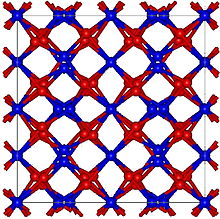
Back أكسيد الإربيوم الثلاثي Arabic اوکسید اربیوم AZB Oxid erbitý Czech Erbium(III)-oxid German Óxido de erbio(III) Spanish اکسید اربیم Persian Erbium(III)oksidi Finnish Oxyde d'erbium(III) French Erbium(III)-oxid Hungarian Erbium(III) oksida ID

| |

| |
| Names | |
|---|---|
| Other names
Erbium oxide, erbia
| |
| Identifiers | |
3D model (JSmol)
|
|
| ChemSpider | |
| ECHA InfoCard | 100.031.847 |
| EC Number |
|
PubChem CID
|
|
CompTox Dashboard (EPA)
|
|
| |
| |
| Properties | |
| Er2O3 | |
| Molar mass | 382.56 g/mol |
| Appearance | pink crystals |
| Density | 8.64 g/cm3 |
| Melting point | 2,344 °C (4,251 °F; 2,617 K) |
| Boiling point | 3,290 °C (5,950 °F; 3,560 K) |
| insoluble in water | |
| +73,920·10−6 cm3/mol | |
| Structure | |
| Cubic, cI80 | |
| Ia-3, No. 206 | |
| Thermochemistry | |
Heat capacity (C)
|
108.5 J·mol−1·K−1 |
Std molar
entropy (S⦵298) |
155.6 J·mol−1·K−1 |
Std enthalpy of
formation (ΔfH⦵298) |
−1897.9 kJ·mol−1 |
| Related compounds | |
Other anions
|
Erbium(III) chloride |
Other cations
|
Holmium(III) oxide, Thulium(III) oxide |
Except where otherwise noted, data are given for materials in their standard state (at 25 °C [77 °F], 100 kPa).
| |
Erbium(III) oxide is the inorganic compound with the formula Er2O3. It is a pink paramagnetic solid. It finds uses in various optical materials.[2]
- ^ Lide, David R. (1998). Handbook of Chemistry and Physics (87 ed.). Boca Raton, FL: CRC Press. pp. 4–57. ISBN 978-0-8493-0594-8.
- ^ Cite error: The named reference
CRwas invoked but never defined (see the help page).